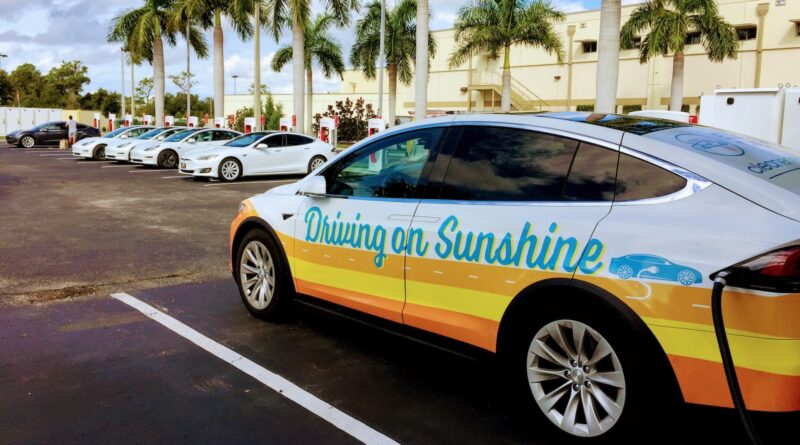Electric Cars & Trucks Are Ideal For City, Town, & County Governments
Many cities, towns, and county governments have adopted low emissions policies to address the issue of global heating. For them, rising sea levels and flooding are not an abstraction, they are part of their daily experience. Many have policies in place to lower carbon emissions or make their communities more resilient. They also have fleets of cars and trucks that allow them to perform the functions of government every day. Converting those cars and trucks to battery power is one way to help serve their communities while meeting their climate goals.
Those cars and trucks need to be serviced on a regular basis — things like oil changes, transmission fluid changes, and replacing brake pads. Those vehicles also need gasoline or diesel fuel to operate. Between maintenance costs and fuel costs, local governments spend a lot of money each year to keep their vehicles in service and ready to do their jobs when needed.
 Electric cars and trucks can help lower those costs for one simple reason. A car or truck with an internal combustion engine and automatic transmission has thousands of moving parts whirling around inside. If any one of those parts fails, it can make the car or truck inoperable. The drivetrain in an electric car or truck had very few moving parts — usually less than a dozen. Fewer parts means fewer things to go wrong, which leads to lower maintenance costs and higher in-service time. Electric cars and trucks can save local governments a lot of money compared to what they spend today on conventional vehicles.
Electric cars and trucks can help lower those costs for one simple reason. A car or truck with an internal combustion engine and automatic transmission has thousands of moving parts whirling around inside. If any one of those parts fails, it can make the car or truck inoperable. The drivetrain in an electric car or truck had very few moving parts — usually less than a dozen. Fewer parts means fewer things to go wrong, which leads to lower maintenance costs and higher in-service time. Electric cars and trucks can save local governments a lot of money compared to what they spend today on conventional vehicles.
Since there is no gasoline or diesel fuel to buy, operating costs are considerably lower. Battery-operated vehicles do need to be charged, but the cost of electricity is typically about a third the cost of gasoline or diesel fuel. There are other cost savings made possible by electric cars and trucks. Replacing brake pads and rotors can cost a lot of money, but EVs have a unique feature. When the driver lifts off the accelerator, the electric motor becomes a generator. That not only feeds electricity back into the battery; it also slows the car down so much that even the brake lights come on.
People who drive electric cars and trucks quickly learn how to take advantage of that feature to avoid using the mechanical brakes most of the time. Less wear and tear on the brakes means less need for changing rotors and pads. Many EVs do not need brake service for as much as 100,000 miles of driving, sometimes more. That’s another way electric cars and trucks can save local governments money. Put all those advantages together and electric cars and trucks can save local governments 50 percent or more of their annual fuel and maintenance costs.
Electric cars and trucks have other advantages as well as lower costs. As city, town, and county governments struggle to meet their environmental goals, using vehicles that leave no pollution in their wake is a big plus. Not only do conventional vehicles spew carbon dioxide — a powerful global heating gas — out of their tail pipes, they also leave a trail of fine particulates behind. Those particulates are so small — 2.5 microns or less — they are invisible to the human eye. (A micron is one millionth of meter.) Those tiny particles are a byproduct of burning gasoline or diesel fuel. They are so tiny that they pass directly into our bloodstream when we breathe and can lead to pulmonary and cardiovascular disease in humans. They are especially harmful to brain development in young children.
Other pollutants from conventional cars and trucks are oxides of nitrogen that can cause damage to the human respiratory tract and increase a person’s vulnerability to, and the severity of, respiratory infections and asthma. Long-term exposure to high levels of nitrogen dioxide can cause chronic lung disease. Why would any government organization want to use vehicles that have a negative impact on the health of its citizens?
Electric Cars And Trucks Are Ideal For Local Governments
Typically, the cars and trucks used by local governments drive relatively short distances each day. Even in large cities like New York and Los Angeles, driving more then 50 miles a day is unusual. Since most EVs can travel 200 miles or more per battery charge, keeping them charged up and ready for the next day requires only that they be plugged in at the end of the workday so that they will be ready for whatever tasks they need to perform the next day.
Charging is usually done at a municipal garage during times when those vehicles are not in use, so there are no concerns about charging during the work day or adding municipal charging equipment throughout the area. A network of EV chargers where the vehicles are parked at night is all that is required. And because they normally drive few miles each day, they won’t need to be charged every day. Every second or third day will be adequate in most cases, meaning governments will not need to have an EV charger for every electric car or truck in its fleet. There are even apps available today that allow employers — including municipalities — to reimburse employees for the cost of electricity used to charge those vehicles at home if they are allowed to take the vehicles home after the work day is over.
Xcelerate Can Help
Xcelerate is a national company that offers financing, leasing, and warranty products for electric car and truck owners both in the private and public sectors. Its focus is on helping people convert to electric vehicles without having to deal with the traditional auto buying/leasing experience. All of its products begin with the idea of providing a positive customer experience that focuses on “Xcelerating” the transition to sustainable transport. Its customers receive industry expert level truth, honesty, and transparent industry analytics, all while maintaining a no pressure, no nonsense approach to their EV lease, purchase, or ownership experience.
Not only can Xcelerate help with buying or leasing an electric vehicle, it also offers extended warranty coverage to supplement the traditional warranty provided by manufacturers. Batteries are typically guaranteed for 8 years or 100,000 miles, but the rest of the vehicle has the standard 4 year or 50,000 mile warranty. Xcelerate can help municipalities manage their service costs once the new car warranty expires.
Xcelerate is the perfect choice for city, town, and county governments that want to transition to using electric cars and trucks but are unsure how the process works. The company consists of a team of former Tesla leaders and partners with 13+ years in the EV space who can help government agencies make the transition seamless and painless, with a great level of clarity. Most of the arrangements can be made online, but personal advice and assistance is only a phone call away. For more about Xcelerate, check out one of the podcasts (here or here) about the company available at CleanTechnica.
This post was sponsored by Xcelerate. If you’d like to run an advertorial on CleanTechnica, you may inquire for more info here.
Have a tip for CleanTechnica? Want to advertise? Want to suggest a guest for our CleanTech Talk podcast? Contact us here.
Latest CleanTechnica.TV Videos

CleanTechnica uses affiliate links. See our policy here.

